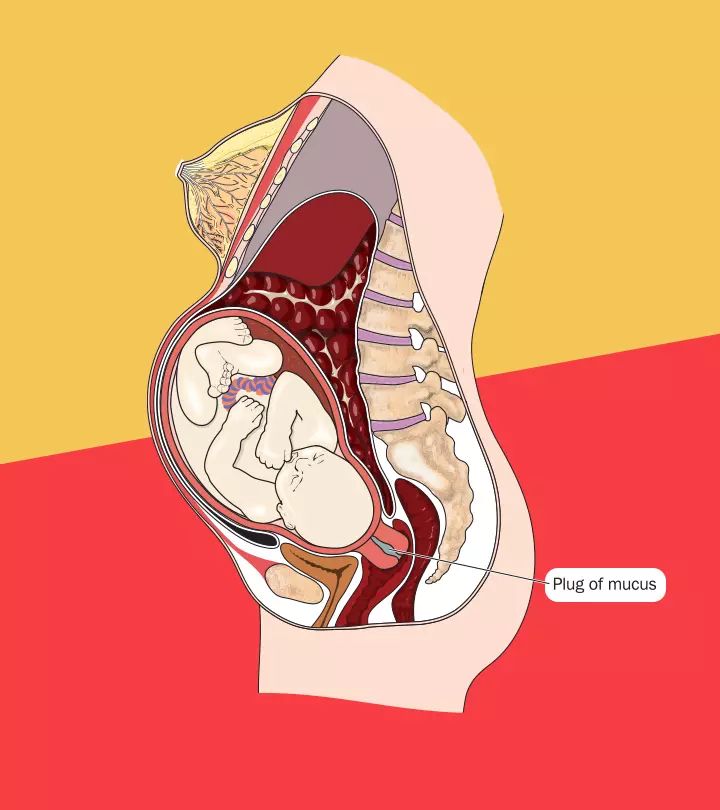
Image: Shutterstock
The mucus plug in pregnancy is a thick layer of mucus that forms in the cervical canal (1). The plug helps prevent the carriers of bacteria and other harmful microorganisms from entering the uterus and infecting the baby.

When the cervix starts to dilate during childbirth and pushes the baby out of the womb, the cervical mucus plug moves into the vagina and eventually exits the body.
Learn more about the mucus plug and what to expect after it comes out of your body through this post.
Key Pointers
- A mucus plug is a pinkish jelly-like mucus layer between the vagina and the uterus.
- It acts as a protector for the fetus by preventing the entry of various microorganisms.
- If you notice the mucus plug in your underwear, inform your doctor as it may indicate a complication or labor based on the gestation period.
- If you notice bloody mucus, check for the signs of labor mentioned in this post.
What Is The Mucus Plug?
A mucus plug is a collection of mucus that forms a thick layer in the cervical canal acting as a cervical seal between the vagina and the uterus. The mucus, which is secreted by the uterus during pregnancy, accumulates and forms the mucus plug or the cervicovaginal mucus barrier. It appears as a jelly-like discharge during pregnancy, either white or slightly pink.
Research has shown that the mucus plug contains high levels of immunoglobulins and phagocytes, which act as a gatekeeper for the fetus (2). The vaginal mucus has the potential for adaptive immunity, protecting the fetus against various infectious microorganisms.
 Did you know?
Did you know?Does Losing The Mucus Plug Indicate Labor?
Losing the mucus plug in pregnancy may not always indicate labor. It may mostly indicate that your cervix has started to dilate in preparation for labor, which could happen anytime later in pregnancy, although it cannot be said when (3). It is always beneficial to look for other symptoms and signs of labor that often begin in the last few weeks of the third trimester.
- Lightening: By the end of the third trimester, the baby starts to settle lower down towards the mother’s pelvis (4). This process is known as lightening or dropping. It may lead to a change in the shape of your belly and frequent urination due to pressure on the bladder. You may also notice a slight change in fetal movements.
- Membrane rupturing: During pregnancy, a protective layer of fluid called the amniotic sac surrounds the developing fetus. Towards the end of the third trimester, the amniotic sac ruptures due to a hole or a tear in it (5). This process is known as the rupturing of membranes. It is also called ‘water breaking’ as the amniotic fluid gushes out of the body.

- Cervical thinning (effacement): The thinning of the lower uterine segment and cervical canal to prepare for the baby’s birth is known as effacement. During this process, the cervix gradually becomes thinner, softer, and shorter (6).
- Dilation: By the end of the third trimester, the cervix softens, becomes thinner, and gradually dilates to facilitate the baby’s delivery. This process of expansion of the cervix is known as cervical dilation (7). The cervix during birth fully dilates to 10cm.
 Point to consider
Point to consider- Strong regular contractions: Muscles of the uterus may contract and relax as you approach your due date (8). When you start to experience strong contractions at closer time intervals, it indicates that you have gone into labor. These contractions gradually increase in frequency and intensity and help push the baby out of the birth canal.

How To Know When You Have Lost The Mucus Plug?

During pregnancy, it can be difficult to differentiate between vaginal discharge and losing the mucus plug. However, you can figure out whether or not you have lost the mucus plug by either checking your underwear for signs of mucus or the tissue paper after going to the bathroom. So, what does a mucus plug look like? The mucus plug is jelly-like in appearance and can either be clear or slightly pink in color.
An anonymous mother of four shares her personal experience when she was 40 weeks pregnant. She says, “I felt something warm on one of my fingers. (I know you are thinking how can you feel it…and eww but that’s why you wash your hands.) I pulled it out to see (the tissue out) the plug right there (i).”
Some women lose their cervical plug all at once, whereas, in others, it can come out in small fragments over a period of a few hours (9).
What To Do After Losing Your Mucus Plug?

Losing the mucus plug is not always an indicator of labor. The time of losing the cervical plug could help you decide the next step.
If you lose your mucus plug within less than 36 weeks of pregnancy, it is important to consult your doctor at the earliest and assess the condition. It might signify a complication in the pregnancy or indicate preterm labor (3).
Losing your mucus plug after 37 weeks of pregnancy is considered normal as it is a sign that the cervical canal is preparing for labor. However, you must see a doctor or visit emergency care if mucus plug expulsion is accompanied by strong uterine contractions, fluid discharge from the vagina, or vaginal bleeding. These signs may indicate that you are getting into labor.
 Be watchful
Be watchfulWhat Is Bloody Show?
Bloody show is the term that is used to describe the phenomenon of the release of a small amount of a mixture of blood and mucus from the vagina (10). It is a very common phenomenon that occurs towards the end of the third trimester of pregnancy.
It should also be noted that bloody show and mucus plug are not the same things. A mucus plug is mostly transparent and contains very little or no amount of blood, while a bloody show is a mixture of blood and mucus and may be a sign that labor is approaching.
How Long After Bloody Show Will You Go Into Labor?

A bloody show is a sign that you will go into labor soon. However, the exact timing of going into labor after a bloody show cannot be determined as it varies from one woman to another (10). It is important to inform your doctor about the same.
A mucus plug in pregnancy is a collection of mucus in the cervical canal. It may prevent the entry of bacteria and other microorganisms into the uterus. The mucus plug can be lost when the cervix begins to dilate. It may usually occur near the due date, and there is no need for concern. However, it is recommended to seek medical advice if you are losing mucus plug before 36 weeks of pregnancy due to possible complications or indications of preterm birth. Before delivery, there can be a bloody show when the blood and mucus plug come out from the vagina.
Frequently Asked Questions
1. What comes first, dilation or mucus plug loss?
The cervix starts to dilate during labor, which in turn leads to the loss of the mucus plug.
2. How much discharge does a mucus plug amount to?
The total volume of the mucus plug amounts to around one to two tablespoons (3).
3. How long after losing the mucus plug does labor start?
Though a mucus plug is passed when the cervix starts dilating, it may take hours, days, or even weeks for the cervix to gradually open and labor to begin (11).
4. What is the difference between a mucus plug and vaginal discharge?
A mucus plug is jelly-like, sticky, and odorless and may be white or pinkish. Vaginal discharge is a clear, white, or cream-colored fluid with a mild odor that helps keep the vagina clean and moist and protects it from infections. It is normal for this discharge to increase during pregnancy. Abnormal vaginal discharges are the ones that look green, brown, or gray, have a cottage cheese-like appearance, smell bad, or are accompanied by pain or itching (3) (12).
Infographic: What Does Mucus Plug Discharge Look Like?
Losing a mucus plug is a sign of labor. Sometimes it may go unnoticed, and many may mistake it for vaginal discharge. Go through the infographic to easily identify a mucus plug’s notable attributes.
Some thing wrong with infographic shortcode. please verify shortcode syntax
It’s possible to lose your mucus plug at 29 weeks. But, what should you do next? Find out what it means and what to expect if it happens to you.
Personal Experience: Source
MomJunction articles include first-hand experiences to provide you with better insights through real-life narratives. Here are the sources of personal accounts referenced in this article.
i. Forty weeks and 3 days pregnant / symptoms and mucus plug.https://lovehappens1234.blogspot.com/2017/07/40-weeks-and-3-days-pregnant-symptoms.html
References
- What does it mean to lose your mucus plug?
https://www.acog.org/womens-health/experts-and-stories/ask-acog/what-does-it-mean-to-lose-your-mucus-plug - Merete Hein et al; (2005); Immunoglobulin levels and phagocytes in the cervical mucus plug at term of pregnancy.
https://pubmed.ncbi.nlm.nih.gov/16026397/ - Mucus Plug.
https://my.clevelandclinic.org/health/symptoms/21606-mucus-plug - Pregnancy: Dropping (Lightening).
https://www.uofmhealth.org/health-library/aa88159 - Rupture of the membranes.
https://www.uofmhealth.org/health-library/hw195832 - Effacement.
https://americanpregnancy.org/healthy-pregnancy/labor-and-birth/effacement/ - OsariemeEvbuomwan et al. Physiology Cervical Dilation.
https://www.ncbi.nlm.nih.gov/books/NBK557582/ - Contractions and signs of labor.
https://www.marchofdimes.org/find-support/topics/birth/contractions-and-signs-labor - Mucus plug: what is it and what does it look like?
https://www.nct.org.uk/information/pregnancy/body-pregnancy/mucus-plug-what-it-and-what-does-it-look - Bloody show.
https://my.clevelandclinic.org/health/symptoms/21605-bloody-show - Mucus Plug – What Is It & What Does It Look Like?
https://americanpregnancy.org/healthy-pregnancy/labor-and-birth/mucus-plug/ - Vaginal discharge during pregnancy.
https://www.pregnancybirthbaby.org.au/vaginal-discharge-during-pregnancy - Mucus Plug.
https://americanpregnancy.org/healthy-pregnancy/labor-and-birth/mucus-plug/
Community Experiences
Join the conversation and become a part of our nurturing community! Share your stories, experiences, and insights to connect with fellow parents.
Read full bio of Dr. Prachi Benara
Read full bio of Sanjana Bhattacharjee
Read full bio of Rebecca Malachi
Read full bio of Reshmi Das


















